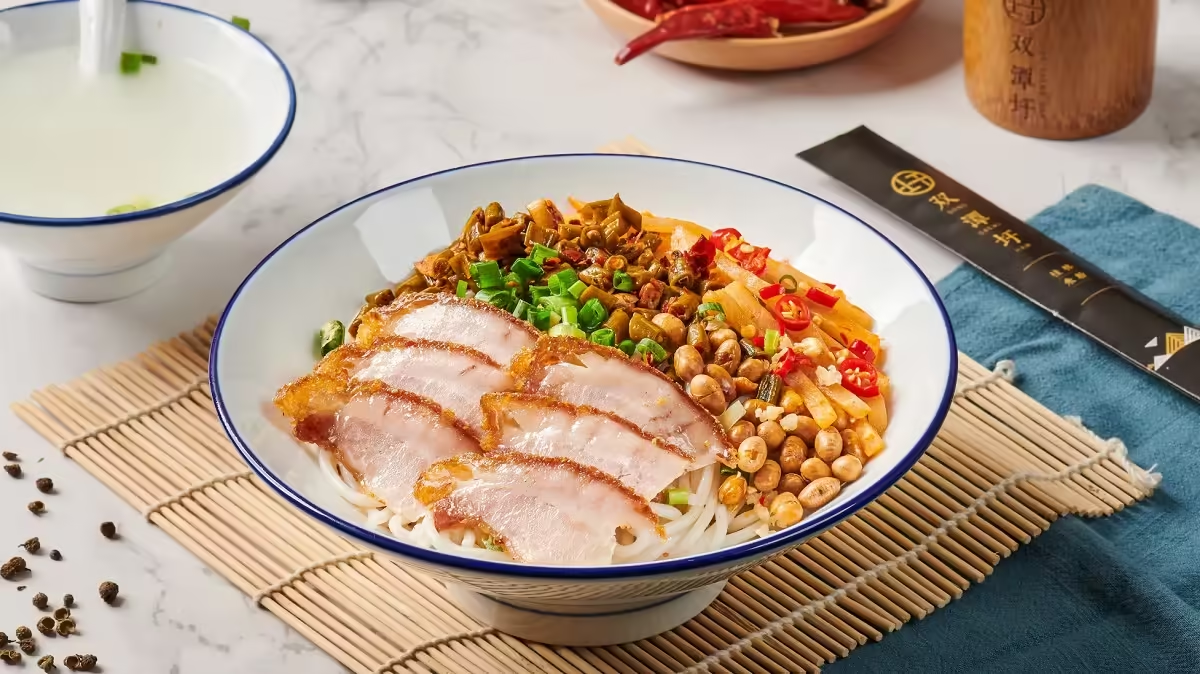Guilin Rice Noodles (桂林米粉) are one of the most iconic snacks from Guilin City in Guangxi. With a history tracing back to the Qin Dynasty, they are deeply rooted in both local tradition and legend. It is said that during Emperor Qin Shi Huang’s reign, his troops stationed in the Lingnan region while constructing the Ling Canal struggled with local cuisine, particularly rice. To address this, military cooks adapted the northern method of noodle-making, using local rice to craft round rice noodles. These were served with a broth infused with Chinese herbs and spices, providing soldiers with a nourishing and satisfying meal. Over time, this culinary tradition evolved into the flavorful Guilin Rice Noodles we know today, celebrated for their unique taste and versatility.
The Craft of Guilin Rice Noodles
- 1. Selecting the Rice: The foundation of Guilin Rice Noodles lies in the quality of its rice. Locally sourced rice from Guilin’s counties is chosen for its superior texture and flavor, making it ideal for crafting noodles.
- 2. Grinding the Rice Paste: The selected rice is thoroughly washed and soaked for several days to achieve the right consistency. It is then ground into a smooth paste, the first step in transforming it into noodles.
- 3. Drying the Paste: The ground rice paste is carefully strained to remove excess water, resulting in a firm dough-like mixture.
- 4. Heating and Softening: The dough is gently heated to improve its texture and elasticity, ensuring the noodles are soft yet resilient.
- 5. Pressing into Noodles: The heated rice dough is pressed through a machine to form noodles of uniform thickness.
- 6. Boiling the Noodles: Finally, the noodles are cooked in boiling water until tender, then cooled and set aside, ready to be served with an array of toppings and broth.
- The Secret of the Broth: Central to Guilin Rice Noodles is the flavorful lu shui (卤水), a masterfully prepared broth. This aromatic liquid is simmered with a blend of spices and herbs such as ginger, Sichuan pepper, black pepper, star anise, and cinnamon. The carefully crafted broth not only enhances the dish’s flavor but also distinguishes it as a culinary masterpiece.
Distinctive Features of Guilin Rice Noodles
- 1. Silky and Resilient Texture: The rice noodles are celebrated for their soft, smooth, and elastic texture. They remain intact when boiled and maintain their chewiness when stir-fried, making them a delight to eat.
- 2. Flavorful Toppings: Guilin Rice Noodles come with an array of diverse and vibrant toppings, such as:
- Crunchy yellow beans and crispy peanuts, adding texture and flavor.
- Tangy pickled bamboo shoots and pickled long beans, providing a zesty balance.
- Fresh vegetables to complement the rich flavors.
- 3. Unique Flavor Profile: The noodles’ combination of springy texture, rich broth, and vibrant toppings results in a dish that is savory, slightly spicy, and deeply satisfying.
Ways to Enjoy Guilin Rice Noodles
One of the reasons Guilin Rice Noodles are so beloved is their versatility. Diners can customize their bowls according to their preferences, selecting from various toppings, broths, and accompaniments. Some popular varieties include:
- Lu cai fen (卤菜粉): Served with braised meats like pork or beef.
- Sheng cai fen (生菜粉): Includes fresh greens for a lighter option.
- Beef brisket noodles (牛腩粉): Features tender, slow-cooked beef.
- San xian fen (三鲜粉): A “three delicacies” version with seafood or mixed proteins.
- Original broth noodles (原汤粉): Highlights the natural flavors of the noodles and broth.
- Sour and Spicy Noodles (酸辣粉): For those who crave a tangy kick.
To enjoy Guilin Rice Noodles, diners often add an assortment of toppings and condiments, such as pork offal, beef slices, or the region’s specialty: braised horse meat. A sprinkle of fresh scallions, a dash of chili oil, and a spoonful of the aromatic broth bring the dish to life.


